
Microbe Notes

DNA Experiments (Griffith & Avery, McCarty, MacLeod & Hershey, Chase)
DNA, deoxyribonucleic acid, is the carrier of all genetic information. It codes genetic information passed on from one generation to another and determines individual attributes like eye color, facial features, etc. Although DNA was first isolated in 1869 by a Swiss scientist, Friedrich Miescher, from nuclei of pus-rich white blood cells (which he called nuclein ), its role in the inheritance of traits wasn’t realized until 1943. Miescher thought that the nuclein, which was slightly acidic and contained a high percentage of phosphorus, lacked the variability to account for its hereditary significance for diversity among organisms. Most of the scientists of his period were convinced by the idea that proteins could be promising candidates for heredity as they were abundant, diverse, and complex molecules, while DNA was supposed to be a boring, repetitive polymer. This notion was put forward as the scientists were aware that genetic information was contained within organic molecules.
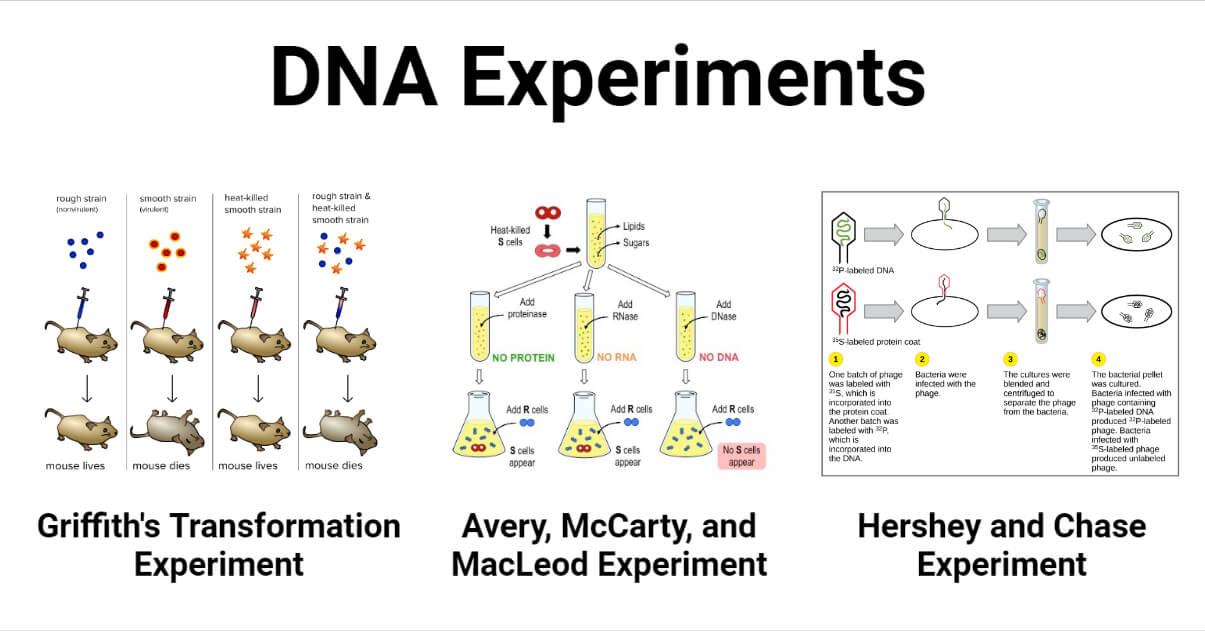
Table of Contents
Interesting Science Videos
Griffith’s Transformation Experiment
In 1928, a young scientist Frederick Griffith discovered the transforming principle. In 1918, millions of people were killed by the terrible Spanish influenza epidemic, and pneumococcal infections were a common cause of death among influenza-infected patients. This triggered him to study the bacteria Streptococcus pneumoniae and work on designing a vaccine against it . It became evident that bacterial pneumonia was caused by multiple strains of S. pneumoniae, and patients developed antibodies against the particular strain with which they were infected. Hence, serum samples and bacterial isolates used in experiments helped to identify DNA as the hereditary material.
He used two related strains of S. pneumoniae and mice and conducted a series of experiments using them.
- When type II R-strain bacteria were grown on a culture plate, they produced rough colonies. They were non-virulent as they lacked an outer polysaccharide coat. Thus, when RII strain bacteria were injected into a mouse, they did not cause any disease and survived.
- When type I S-strain bacteria were grown on a culture plate, they produced smooth, glistening, and white colonies. The smooth appearance was apparent due to a polysaccharide coat around them that provided resistance to the host’s immune system. It was virulent and thus, when injected into a mouse, resulted in pneumonia and death.
- In 1929, Griffith experimented by injecting mice with heat-killed SI strain (i.e., SI strain bacteria exposed to high temperature ensuing their death). But, this failed to harm the mice, and they survived.
- Surprisingly, when he mixed heat-treated SI cells with live RII cells and injected the mixture into the mice, the mice died because of pneumonia. Additionally, when he collected a blood sample from the dead mouse, he found that sample to contain live S-strain bacteria.
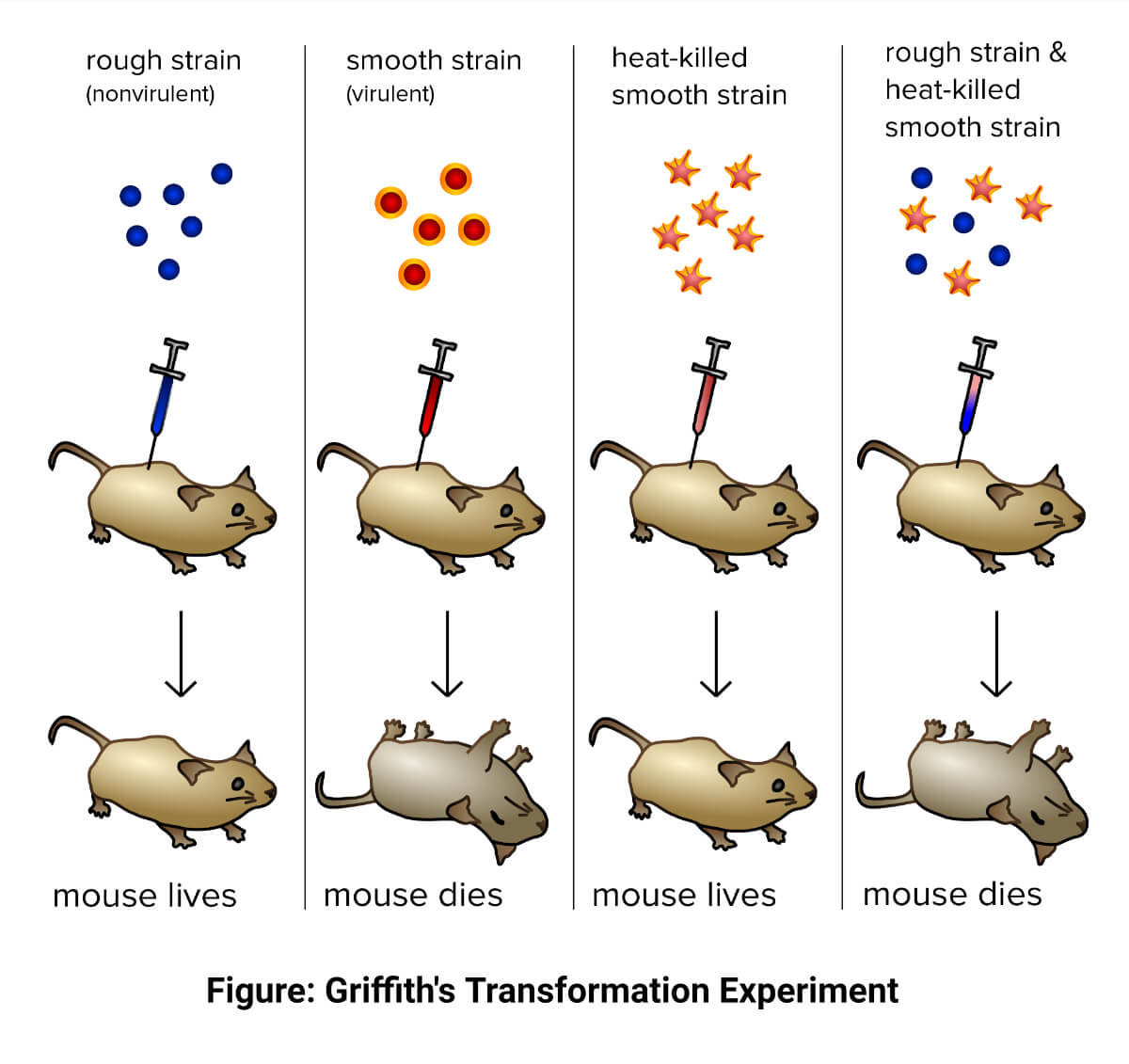
Conclusion of Griffith’s Transformation Experiment
Based on the above results, he inferred that something must have been transferred from the heat-treated S strain into non-virulent R strain bacteria that transformed them into smooth coated and virulent bacteria. Thus, the material was referred to as the transforming principle.
Following this, he continued with his research through the 1930s, although he couldn’t make much progress. In 1941, he was hit by a German bomb, and he died.
Avery, McCarty, and MacLeod Experiment
During World War II, in 1943, Oswald Avery, Maclyn McCarty, and Colin MacLeod working at Rockefeller University in New York, dedicated themselves to continuing the work of Griffith in order to determine the biochemical nature of Griffith’s transforming principle in an in vitro system. They used the phenotype of S. pneumoniae cells expressed on blood agar in order to figure out whether transformation had taken place or not, rather than working with mice. The transforming principle was partially purified from the cell extract (i.e., cell-free extract of heat-killed type III S cells) to determine which macromolecule of S cell transformed type II R-strain into the type III S-strain. They demonstrated DNA to be that particular transforming principle.
- Initially, type III S cells were heat-killed, and lipids and carbohydrates were removed from the solution.
- Secondly, they treated heat-killed S cells with digestive enzymes such as RNases and proteases to degrade RNA and proteins. Subsequently, they also treated it with DNases to digest DNA, each added separately in different tubes.
- Eventually, they introduced living type IIR cells mixed with heat-killed IIIS cells onto the culture medium containing antibodies for IIR cells. Antibodies for IIR cells were used to inactivate some IIR cells such that their number doesn’t exceed the count of IIIS cells. that help to provide the distinct phenotypic differences in culture media that contained transformed S strain bacteria.
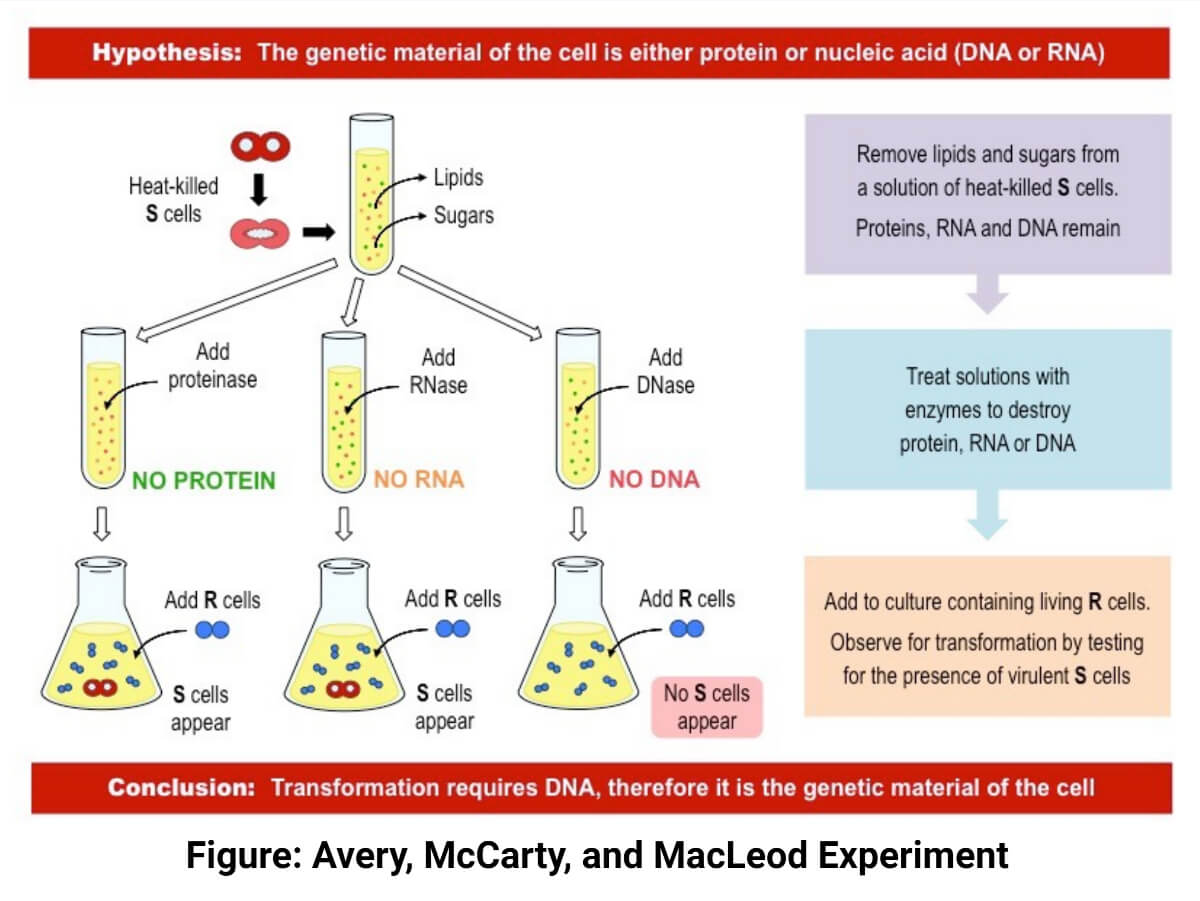
Observation of Avery, McCarty, and MacLeod Experiment
The culture treated with DNase did not yield transformed type III S strain bacteria which indicated that DNA was the hereditary material responsible for transformation.
Conclusion of Avery, McCarty, and MacLeod Experiment
DNA was found to be the genetic material that was being transferred between cells, not proteins.
Hershey and Chase Experiment
Although Avery and his fellows found that DNA was the hereditary material, the scientists were reluctant to accept the finding. But, not that long afterward, eight years after in 1952, Alfred Hershey and Martha Chase concluded that DNA is the genetic material. Their experimental tool was bacteriophages-viruses that attack bacteria which specifically involved the infection of Escherichia coli with T2 bacteriophage.
T2 virus depends on the host body for its reproduction process. When they find bacteria as a host cell, they adhere to its surface and inject its genetic material into the bacteria. The injected hereditary material hijacks the host’s machinery such that a large number of viral particles are released from them. T2 phage consists of only proteins (on the outer protein coat) and DNA (core) that could be potential genetic material to instruct E. coli to develop its progeny. They experimented to determine whether protein or DNA from the virus entered into the bacteria.
- Bacteriophage was allowed to grow on two of the medium: one containing a radioactive isotope of phosphorus( 32 P) and the other containing a radioactive isotope of sulfur ( 35 S).
- Phages grown on radioactive phosphorus( 32 P) contained radioactive P labeled DNA (not radioactive protein) as DNA contains phosphorus but not sulfur.
- Similarly, the viruses grown in the medium containing radioactive sulfur ( 35 S) contained radioactive 35 S labeled protein (but not radioactive DNA) because sulfur is found in many proteins but is absent from DNA.
- E. coli were introduced to be infected by the radioactive phages.
- After the progression of infection, the blender was used to remove the remains of phage and phage parts from the outside of the bacteria, followed by centrifugation in order to separate the bacteria from the phage debris.
- Centrifugation results in the settling down of heavier particles like bacteria in the form of pellet while those light particles such as medium, phage, and phage parts, etc., float near the top of the tube, called supernatant.
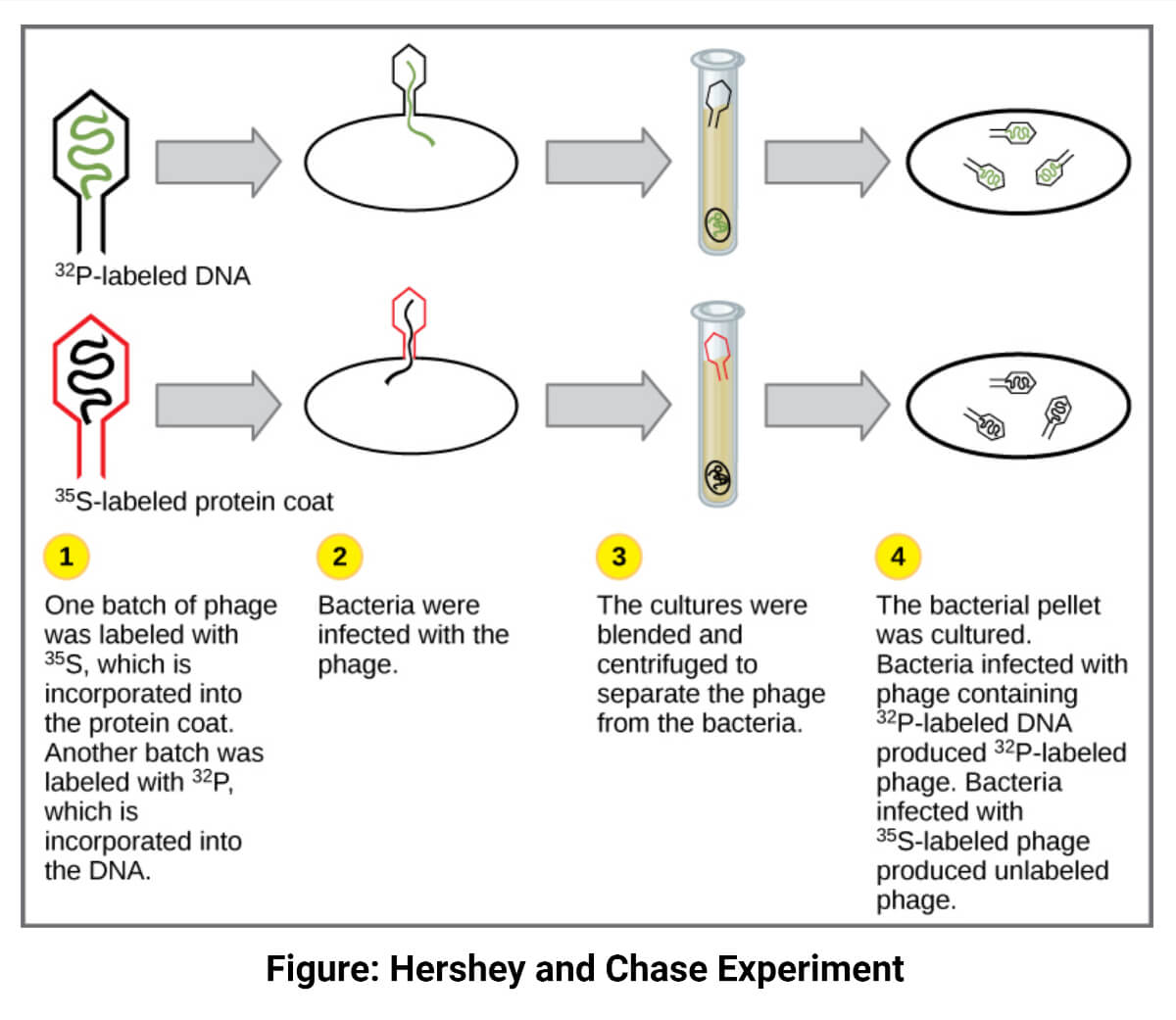
Observation of Hershey and Chase Experiment
On measuring radioactivity in the pellet and supernatant in both media, 32 P was found in large amount in the pellet while 35 S in the supernatant that is pellet contained radioactively P labeled infected bacterial cells and supernatant was enriched with radioactively S labeled phage and phage parts.
Conclusion of Hershey and Chase Experiment
Hershey and Chase deduced that it was DNA, not protein which got injected into host cells, and thus, DNA is the hereditary material that is passed from virus to bacteria.
- Fry, M. (2016). Landmark Experiments in Molecular Biology. Academic Press.
- https://bio.libretexts.org/Bookshelves/Introductory_and_General_Biology/Book%3A_Introductory_Biology_(CK-12)/04%3A_Molecular_Biology/4.02%3A_DNA_the_Genetic_Material
- https://byjus.com/biology/dna-genetic-material/
- https://bio.libretexts.org/Bookshelves/Genetics/Book%3A_Online_Open_Genetics_(Nickle_and_Barrette-Ng)/01%3A_Overview_DNA_and_Genes/1.02%3A_DNA_is_the_Genetic_Material
- https://www.toppr.com/guides/biology/the-molecular-basis-of-inheritance/the-genetic-material/
- https://www.nature.com/scitable/topicpage/discovery-of-dna-as-the-hereditary-material-340/
- https://www.biologydiscussion.com/genetics/dna-as-a-genetic-material-biology/56216
- https://www.nature.com/scitable/topicpage/discovery-of-the-function-of-dna-resulted-6494318/
- https://www.ndsu.edu/pubweb/~mcclean/plsc411/DNA%20replication%20sequencing%20revision%202017.pdf
- https://www.britannica.com/biography/Frederick-Griffith
- https://ib.bioninja.com.au/higher-level/topic-7-nucleic-acids/71-dna-structure-and-replic/dna-experiments.html
- https://biolearnspot.blogspot.com/2017/11/experiments-of-avery-macleod-and.html
- https://www.khanacademy.org/science/biology/dna-as-the-genetic-material/dna-discovery-and-structure/a/classic-experiments-dna-as-the-genetic-material
About Author
Prakriti Karki
Leave a Comment Cancel reply
Save my name, email, and website in this browser for the next time I comment.
This site uses Akismet to reduce spam. Learn how your comment data is processed .
- Introduction to Genomics
- Educational Resources
- Policy Issues in Genomics
- The Human Genome Project
- Funding Opportunities
- Funded Programs & Projects
- Division and Program Directors
- Scientific Program Analysts
- Contacts by Research Area
- News & Events
- Research Areas
- Research Investigators
- Research Projects
- Clinical Research
- Data Tools & Resources
- Genomics & Medicine
- Family Health History
- For Patients & Families
- For Health Professionals
- Jobs at NHGRI
- Training at NHGRI
- Funding for Research Training
- Professional Development Programs
- NHGRI Culture
- Social Media
- Broadcast Media
- Image Gallery
- Press Resources
- Organization
- NHGRI Director
- Mission and Vision
- Policies and Guidance
- Institute Advisors
- Strategic Vision
- Leadership Initiatives
- Diversity, Equity, and Inclusion
- Partner with NHGRI
- Staff Search
1944: DNA is \"Transforming Principle\"
1944: dna is "transforming principle".
Avery, MacLeod and McCarty identified DNA as the "transforming principle" while studying Streptococcus pneumoniae , bacteria that can cause pneumonia. The bacteriologists were interested in the difference between two strains of Streptococci that Frederick Griffith had identified in 1923: one, the S (smooth) strain, has a polysaccharide coat and produces smooth, shiny colonies on a lab plate; the other, the R (rough) strain, lacks the coat and produces colonies that look rough and irregular. The relatively harmless R strain lacks an enzyme needed to make the capsule found in the virulent S strain.
Griffith had discovered that he could convert the R strain into the virulent S strain. After he injected mice with R strain cells and, simultaneously, with heat-killed cells of the S strain, the mice developed pneumonia and died. In their blood, Griffith found live bacteria of the deadly S type. The S strain extract somehow had "transformed" the R strain bacteria to S form. Avery and members of his lab studied transformation in fits and starts over the next 15 years. In the early 1940s, they began a concerted effort to purify the "transforming principle" and understand its chemical nature.
Bacteriologists suspected the transforming factor was some kind of protein. The transforming principle could be precipitated with alcohol, which showed that it was not a carbohydrate like the polysaccharide coat itself. But Avery and McCarty observed that proteases - enzymes that degrade proteins - did not destroy the transforming principle. Neither did lipases - enzymes that digest lipids. They found that the transforming substance was rich in nucleic acids, but ribonuclease, which digests RNA, did not inactivate the substance. They also found that the transforming principle had a high molecular weight. They had isolated DNA. This was the agent that could produce an enduring, heritable change in an organism.
Until then, biochemists had assumed that deoxyribonucleic acid was a relatively unimportant, structural chemical in chromosomes and that proteins, with their greater chemical complexity, transmitted genetic traits.
« Previous Event | Next Event »
Last updated: April 23, 2013
This page has been archived and is no longer updated
Discovery of DNA as the Hereditary Material using Streptococcus pneumoniae
No one could have predicted that experiments designed to understand bacterial pneumonia would lead to the discovery of DNA as the hereditary material. In the early part of the twentieth century, before the advent of antibiotics, pneumococcal infections claimed many more lives than they do today. Researchers on both sides of the Atlantic were thus actively engaged in studying Streptococcus pneumoniae , the bacterium responsible for clinical infections. Early on, it became apparent that multiple strains of S. pneumoniae were responsible for causing bacterial pnuemonia. Researchers also noted that patients developed antibodies to the particular strain, or serotype, with which they were infected, but these antisera were not universally reactive against pneumococcal strains. However, the bacterial isolates and serum samples from these clinical studies provided the critical reagents for the experiments that ultimately led to the identification of DNA as the hereditary material.
Pneumococcal Research Provides Critical Tools in DNA Research
Although numerous scientists engaged in pneumococcal research during the first half of the twentieth century, two of these researchers played an especially important role in the course of events that led to the discovery of DNA as the hereditary material . One of these individuals was Oswald Avery . Avery joined the Rockefeller Institute for Medical Research, now the Rockefeller University, in 1913 as part of a team seeking to develop a therapeutic serum for treating lobular pneumonia. Avery believed that knowledge of the chemical composition of the pneumococcus bacterium was essential for understanding and treating the disease . He perfected his biochemical technique by focusing on the chemical composition of the capsule that surrounded virulent S strains of pneumococci. In his early work, Avery helped establish that polysaccharides were a major component of the pneumococcal capsule and that capsules from different serotypes of pneumococci had distinctive polysaccharide compositions. Avery also concerned himself with the role of capsules in pathogenicity, as capsules were notably absent from the surface of nonvirulent R forms of streptococci. Defying the conventional wisdom of the time, Avery hypothesized that the polysaccharides in the capsules were the actual antigens stimulating the production of antibodies in infected patients (Avery & Goebel, 1933).
Purification of the Active Transforming Principle
When Avery first became aware of Griffith's results, he treated them with skepticism. Other researchers and laboratories, however, were quick to reproduce and build upon Griffith's data. Within a few years, Sia and Dawson (1931) showed that transformation could be carried out in liquid cultures of pneumococci as well as in mice, allowing more precise control of environmental variables in transformation experiments. In 1932, Alloway further demonstrated that the active transforming principle was present in sterile, cell-free extracts prepared from heat-treated pneumococci by filtration. These additional findings convinced Avery that the transforming principle could be identified, and he applied his considerable biochemical expertise to its purification from pneumococcal extracts (Avery et al. , 1944).
A critical aspect of any biochemical purification is the development of an assay, or a way to measure the activity of interest. For their experiments, Avery and his colleagues developed conditions under which R cells could be reliably transformed into S cells using extracts of heat-killed Type III S cells. These same conditions could then be used to measure transforming activity in fractions obtained at different steps in the purification process. To quantify the actual amount of transforming principle in a fraction, each sample was tested at a series of increasing dilutions. These data represent four identical experiments in which Avery and his colleagues tested the ability of the purified factor, designated preparation 44, to transform Type II R cells into Type III S cells. The transforming activity was very concentrated in the extract, since it could be diluted ten-thousand-fold without losing its transforming ability. Fractions that maintained transforming activity at the highest dilutions were deemed to possess the highest concentration of transforming activity. Specifically, when at least 0.01μg of the extract was added to cells, transformation was observed. When any less than 0.01μg was added, the transformation was inconsistent (comparing samples 1 and 3 with 2 and 4) (Figure 2).
Physical Characterization of the Transforming Principle
Avery and his colleagues submitted the purified transforming principle to rigorous physical characterization in order to demonstrate that it possessed the properties expected of DNA (Avery et al. , 1944). The elemental composition of the purified transforming compound was close to the theoretical values for DNA (last row, sodium desoxyribonucleate) (Figure 3). Significantly, the purified principle had a high phosphorous content, which is characteristic of DNA, but not of proteins.
Consistent with these results, the factor gave positive reactions in chemical tests for DNA, but negative or weakly positive reactions in tests for proteins and RNA . Other tests indicated that the transforming principle was a very large molecule that absorbed the same spectrum of ultraviolet light as DNA. However, the most definitive proof that the transforming principle was DNA was its sensitivity to specific enzymes, called DNAses, that specifically degrade different kinds of DNA. Avery and his colleagues were able to show that transforming activity was not destroyed by enzymes that degrade proteins or RNA. At the time, Avery could not obtain samples of pure DNAse. Instead, Avery and his colleagues used crude preparations from animal tissues that were known to contain DNAse activity. They then measured the ability of these various crude preparations to destroy the transforming principle in parallel with measurements of phosphatase, esterase, and DNAse activities in the same extracts. In all cases, the ability of the crude extracts to destroy the transforming principle was proportional to their DNAse activity, measured with pure calf thymus DNA as substrate (Figure 4).
DNA Has the Properties Expected of Genes
References and recommended reading.
- Add Content to Group
Article History
Flag inappropriate.


Email your Friend

- | Lead Editor: Bob Moss

Within this Subject (34)
- Applications in Biotechnology (4)
- Discovery of Genetic Material (4)
- DNA Replication (6)
- Gene Copies (5)
- Jumping Genes (4)
- RNA (7)
- Transcription & Translation (4)
Other Topic Rooms
- Gene Inheritance and Transmission
- Gene Expression and Regulation
- Nucleic Acid Structure and Function
- Chromosomes and Cytogenetics
- Evolutionary Genetics
- Population and Quantitative Genetics
- Genes and Disease
- Genetics and Society
- Cell Origins and Metabolism
- Proteins and Gene Expression
- Subcellular Compartments
- Cell Communication
- Cell Cycle and Cell Division
© 2014 Nature Education
- Press Room |
- Terms of Use |
- Privacy Notice |

Visual Browse
Browse Course Material
Course info, instructors.
- Prof. Eric Lander
- Prof. Robert Weinberg
- Prof. Tyler Jacks
- Prof. Hazel Sive
- Prof. Graham Walker
- Prof. Sallie Chisholm
- Dr. Michelle Mischke
Departments
As taught in, learning resource types, fundamentals of biology, dna structure, classic experiments.
« Previous | Next »
Session Overview
| This session will explain early experiments in Molecular Biology. Outlined are classic experiments by Avery, Griffith, Hershey, and Chase that demonstrated DNA was the hereditary material, background on Chargaff, Watson, Crick, and Franklin and how their discoveries contributed to the discovery of the structure of DNA, and details regarding how the semi-conservative model of DNA replication was shown by Meselson and Stahl.
|
Session Activities
Lecture video.
Watch the lecture video excerpt
- DNA Structure and Classic experiments, Excerpt 1
Check Yourself
Although the fractions were not completely pure, the fractions that had transforming abilities were greatly enriched for nucleic acid, specifically DNA.
What functional group is found on the 3’ end of a nucleotide? carboxyl close hydroxyl check nitrogenous base close phosphate close Check
Which of the following is found in DNA but not in protein? Carbon close Nitrogen close Oxygen close Phosphorus check Sulphur close Check
- DNA Structure and Classic experiments, Excerpt 2
In density gradient centrifugation, which of the following DNA molecules will travel the farthest down the tube? a 14N-14N duplex close a 14N-15N duplex close a 15N-15N duplex check Check
Practice Problems
- Problems (PDF)
- Solutions (PDF)
Further Study
Suggested topics for further study in an introductory-level biology textbook.
- Classic experiments by Avery, Griffith, and Hershey/Chase
- Watson, Crick, and Franklin
- Semi-conservative model of DNA replication
Useful Links
- Hershey and Chase Experiment
- Meselson and Stahl Experiment
- “ Molecular Structure of Nucleic Acids ” (The original Watson and Crick paper)

You are leaving MIT OpenCourseWare
Concept 17 A gene is made of DNA.

It's hard to imagine now the impact that Avery's experiments must have had. Until Avery's experiments, scientists weren't even sure that bacteria had genes.

Avery's experiments showed that DNA is the tranforming principle, but he didn't try to figure out how transformation works. How do you think transformation works?
Funded by --> The Josiah Macy, Jr. Foundation © 2002 - 2011, DNA Learning Center , Cold Spring Harbor Laboratory . All rights reserved.
- CLASSICAL GENETICS

- GENETIC ORGANIZATION AND CONTROL
How Did Scientists Prove That DNA Is Our Genetic Material?
Griffith experiment, avery, macleod and mccarty experiment, hershey and chase experiment.
Three seminal experiments proved, without doubt, that DNA was the genetic material, and not proteins. These experiments were the Griffith experiment, Avery, MacLeod, and McCarthy Experiment, and finally the Hershey-Chase Experiment.
DNA is the fundamental component of our being. The human body is merely the carrier for this genetic material, passing it down from generation to generation. Our purpose is to ensure the survival of the species. Humans are to DNA like a fruit is to a seed. We are just an outer covering to ensure the safe passage and protection of the source code of our existence through time. Makes you feel pretty useless, doesn’t it?
However, that’s not what I want you to focus on. The main focus is, how did we discover that DNA is the carrier of information? How did we determine that it wasn’t something else, like proteins? After all, proteins are also present in every cell.
For a long time this debate had been going on. Even after Gregor Mendel formed the 3 laws of inheritance , it wasn’t accepted by the scientific community for 45 years. The reason? There was no concept of DNA or genes being the information carriers! The whole debate was finally put to rest by 3 main experiments carried out by independent researchers, which formed the basis of all our evolutionary and molecular biology studies.
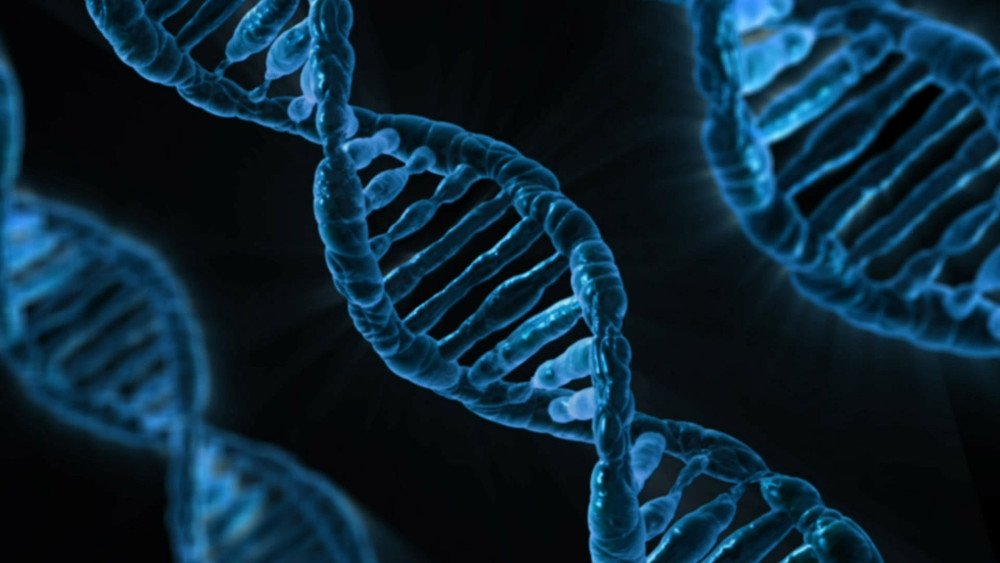
Recommended Video for you:
The first step was taken by Frederick Griffith in the year 1928. He was a bacteriologist who focused on epidemiology. Griffith was studying how Streptococcus pneumoniae caused an infection. He was working with 2 strains of the bacteria called the S and R strains. S strain organisms, when cultured in the lab, gave rise to bacterial colonies with a smooth appearance. This was due to a shiny, polysaccharide coat, which is supposed to be their virulence factor. A virulence factor is any quality or factor of a pathogen that helps it in achieving its goal – causing a disease! The other strain was the R strain. This strain gave rise to colonies that didn’t possess the polysaccharide coat, and therefore had a ‘rough’ appearance. Therefore, the S strain was virulent and the R strain was avirulent.
Griffith took 4 mice and injected them with different solutions. The first one was injected with the S strain organisms; the second one was injected with the R strain organisms; the third mouse was injected with heat-killed S strain organisms; and the last one was injected with a mixture of heat-killed S strain and live R strain organisms. The result? The first and fourth mice died due to the infection, while the second and third mice survived. When he extracted the infectious agent from the dead mice, in both cases, he found S strain organisms.
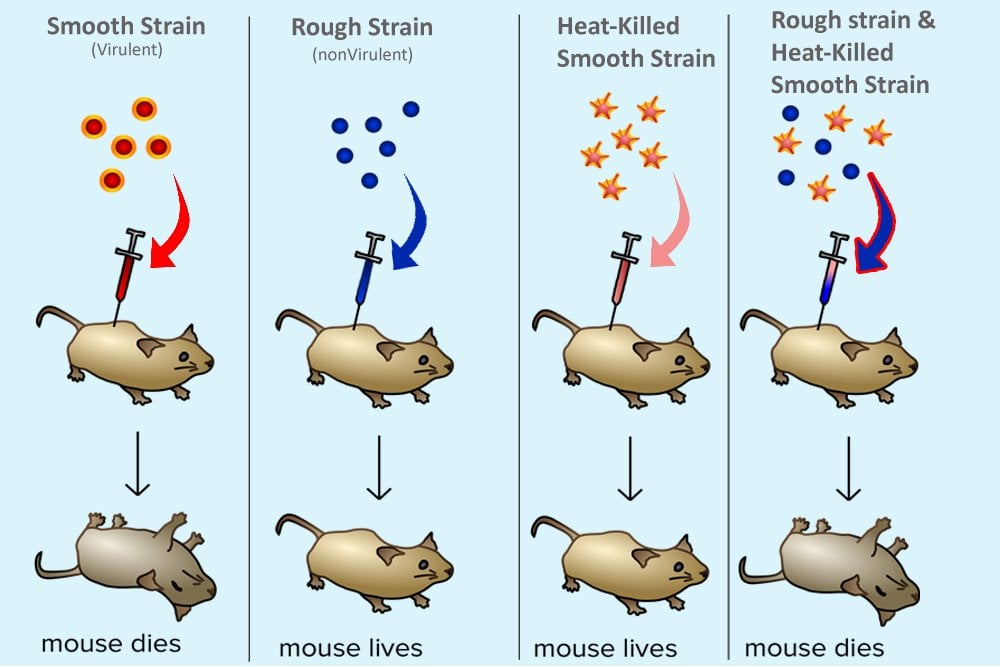
Let’s break it down. The first 2 mice showed that S strain is the virulent strain, while the R strain is avirulent. The third mouse proved that heat-killed S strain organisms cannot cause an infection. Now here is where it gets interesting. The death of the 4 th mouse, and the retrieval of live S strain organisms showed that, somehow, the heat-killed S strain organisms had caused the transformation of live R strain organisms to live S strain organisms.
This was called the transformation experiment… not particularly creative in the naming department.
Also Read: Does Human DNA Change With Time?
While Griffith’s experiment had provided a surprising result, it wasn’t clear as to what component of the dead S strain bacteria were responsible for the transformation. 16 years later, in 1944, Oswald Avery, Colin Macleod and MacLynn McCarty solved this puzzle.
They worked with a batch of heat-killed S strain bacteria. They divided it into 5 batches. In the first batch, they destroyed the polysaccharide coat of the bacteria; in the second batch they destroyed its lipid content; they destroyed the RNA of the bacteria in the third batch; with the fourth batch, they destroyed the proteins; and in the last batch, they destroyed the DNA. Each of these batches was individually mixed with live R strain bacteria and injected into individual mice.
From all 5 mice, all of them died except the last mouse. From all the dead mice, live S strain bacteria was retrieved. This experiment clearly proved that when the DNA of the S strain bacteria were destroyed, they lost the ability to transform the R strain bacteria into live S strain ones. When other components, such as the polysaccharide coat, lipid, RNA or protein were destroyed, transformation still took place. Although the polysaccharide coat was a virulent factor, it wasn’t responsible for the transfer of the genetic matter.
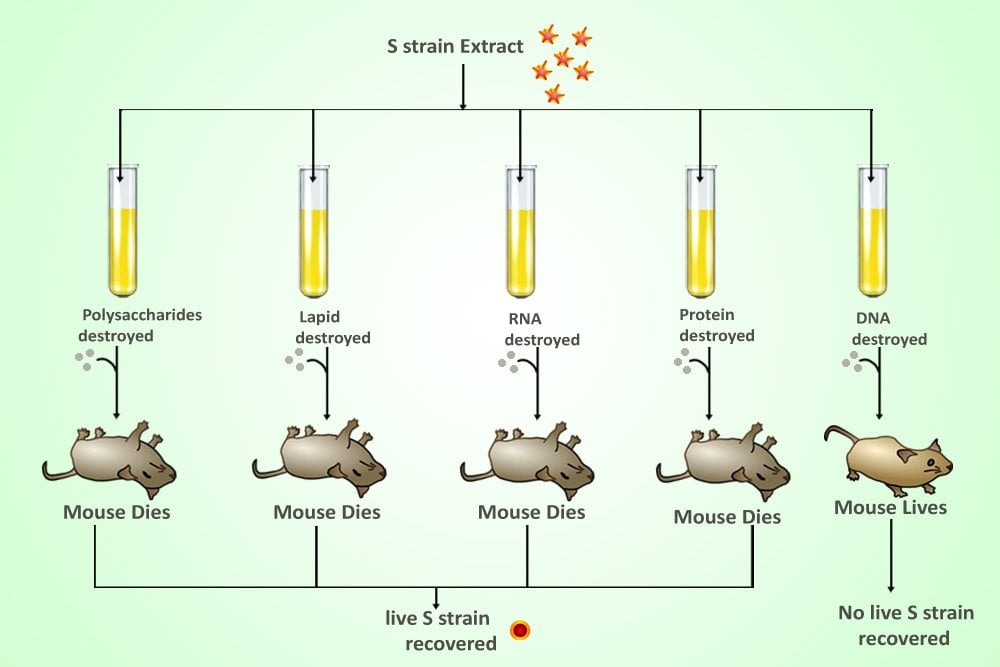
Even after the compelling evidence provided by the Avery, Macleod and McCarty experiment, there were still a few skeptics out there who weren’t convinced. The debate still raged between proteins and DNA. However, the Hershey – Chase experiment permanently put an end to this long-standing debate.
Alfred Hershey and Martha Chase in 1952, performed an experiment that proved, without a doubt, that DNA was the carrier of information. For their experiment, they employed the use of the bacteriophage T2. A bacteriophage is a virus that only infects bacteria. This particular virus infects Escherichia coli . T2 had a simple structure that consisted of just 2 components – an outer protein casing and the inner DNA. Hershey and Chase took 2 different samples of T2. They grew one sample with 32 P, which is the radioactive isotope of phosphorus, and the other sample was grown with 35 S, the radioactive isotope of sulphur!
The protein coat has sulphur and no phosphorus, while the DNA material has phosphorus but no sulphur. Thus, the 2 samples were labelled with 2 different radioactive isotopes.
The viruses were then allowed to infect the E. coli . Once the infection was done, the experimental solution was subjected to blending and centrifugation. The former removed the ghost shells, or empty shells of the virus from the body of the bacteria. The latter separated the bacteria from everything else. The bacterial solution and the supernatant were then checked for their radioactivity .
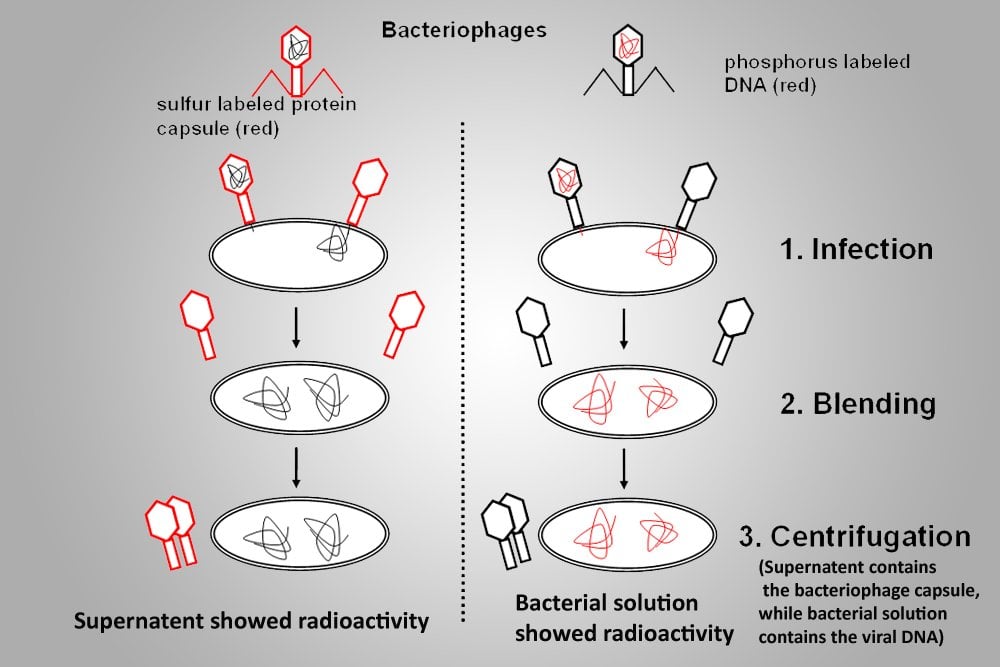
In the first sample, where 32 P was used, the bacterial solution showed radioactivity, whereas the supernatant barely had any radioactivity. In the sample where 35 S was used, the bacterial solution didn’t show any radioactivity, but the supernatant did.
This experiment clearly showed that DNA was transferred from the phage to the bacteria, thus establishing its place as the fundamental carrier of genetic information.
Until the final experiment performed by Hershey and Chase, DNA was thought to be a rather simple and boring molecule. It wasn’t considered structured enough to perform such a complicated and extremely important function. However, after this experiment, scientists started paying much more attention to DNA, leading us to where we are in research today!
Also Read: A History Of DNA: Who Discovered DNA?
- How was DNA shown to be the genetic material?. The University of Texas at Austin
- The Genetic Material - DNA - CSUN. California State University, Northridge
- Home - Books - NCBI. National Center for Biotechnology Information
Mahak Jalan has a BSc degree in Zoology from Mumbai University in India. She loves animals, books and biology. She has a general assumption that everyone shares her enthusiasm about the human body! An introvert by nature, she finds solace in music and writing.
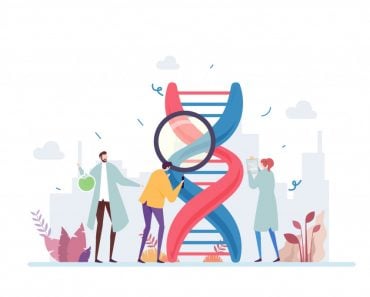
What Is DNA And How Does It Work?
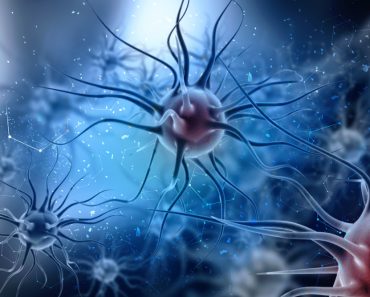
Where Did Viruses Come From?

What Does RNA Do In A Cell?
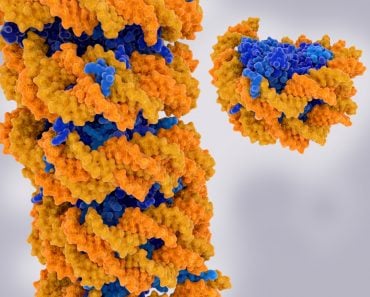
Chromatin: Structure And Function Within A Cell
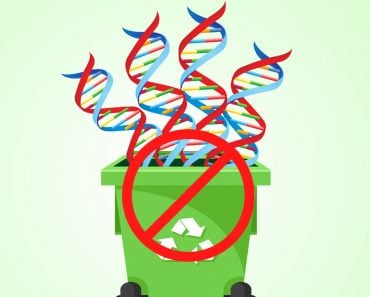
Is 98% Of Our DNA Really Junk?
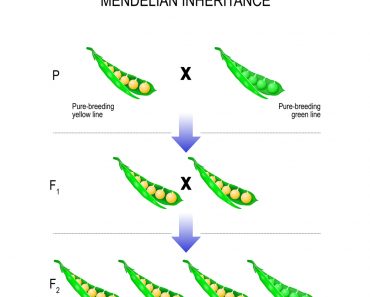
Mendel’s Laws Of Inheritance: The Law Of Segregation

Why Do Some People Look More Like Their Grandparents Than Their Parents?

Photosynthesis: The Biochemistry Behind How Plants Make Their Food

What are Mutations and what are the different types of Mutations?
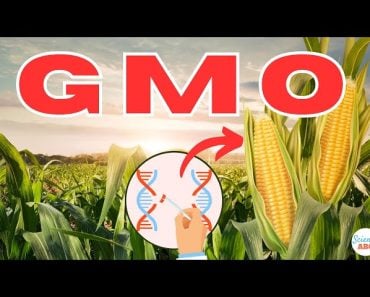
What are GMOs (Genetically Modified Organisms)?

What is Evolution: A REALLY SIMPLE and Brief Explanation

Can We Bring Back Dinosaurs (Just Like In Jurassic Park)?
- Field Trips
- Middle School Labs
- High School Labs
- Ötzi the Iceman Field Trips
- CUNY City Tech Field Trips
- School Membership Program
- Science Camps
- School Break Bio!
- Saturday DNA!
- DNALC LI Exhibition
- DNALC NYC Exhibition
- Meet a Scientist Series
- Open Events
- Student Research
- Citizen Science
- Educator Training
Websites & Apps
- Apps & Textbooks
3D Animations
- Biology Animations
- Students Talk Science
- Search All Media
- About DNALC
- Dolan DNA Learning Center
- Harlem DNA Lab
- DNALC NYC at CityTech
- Regeneron DNALC
- Licensed Centers
- Collaborations
- History: Annual Reports
- Publications
- Staff & Employment
- Contact & Directions
Animation 17: A gene is made of DNA.
- Description
Oswald Avery explains Fred Griffith's and his own work with Pneumococcus bacteria.
How do you do? I'm Oswald Avery. My colleagues and I did a series of experiments using strains of Pneumococcus bacteria, which cause pneumonia. Pneumococcus grows in the body of the host, but, like other types of bacteria, also can be grown on solid or liquid cultures. In 1928, Fred Griffith published a study on the different strains of Pneumococcus. Two in particular, S and R, look different. The S colonies have a smooth surface, and the R colonies look rough. The S colonies look smooth because each bacterium has a capsule-like coat made of sugars. This coat protects the S bacteria from the host's immune system, and so the S strain is infectious. The coat-less R strain is not. Griffith found that mice injected with the S strain develop pneumonia and die within days. Mice injected with the R strain do not get pneumonia. Griffith noticed that different strains of Pneumococcus could be cultured from one patient. He began to wonder if one strain could change into another. To test this idea, he did a series of experiments using the R and S strains. First, Griffith heated the S strain culture to kill the bacteria. As predicted, when injected into mice, the heat-killed bacteria did not produce an infection. Griffith co-injected the heat-killed S with live R into mice, and, much to his surprise, the mice developed pneumonia and died. Even more astonishing, Griffith was able to isolate live S strain from the blood of infected mice. These cultures could infect other mice. S strain cultured from infected mice remained active — showing that the change was stable and inherited. Griffith concluded that some "principle" was transferred from the heat-killed S to the R strain. The principle transformed the R into the infective S strain with a smooth coat. When I read about Griffith's results, I became very interested in the identity of this transforming "principle." Colin MacLeod, Maclyn McCarty, and I began experimenting using a test tube assay instead of mice. We used detergent to lyse the heat-killed S cells. Then we used this lysate for transformation assays. The test tube assays worked well, and showed us that the heat-killed S lysate could change R to S. The transforming principle was something in the lysate. We tested each of the lysate components for the transforming activity. First, we incubated the heat-killed S lysate with an enzyme, SIII, that completely chewed up the sugar coat. We tested the transforming ability of the sugar coat-less S lysates. The sugar coat-less S lysate was still able to transform. This told us that the R strain was not just assembling a new S sugar coat from the pieces. Next, we incubated the coat-less S extract with protein digesting enzymes — trypsin and chymotrypsin. Next, we incubated the coat-less S extract with protein digesting enzymes — trypsin and chymotrypsin. We tested this lysate's ability to transform. This protein-less lysate was still able to transform. So, the transforming principle is not protein. While we were testing and purifying the lysate, we precipitated nucleic acids — DNA and RNA — with alcohol. We were the first to isolate nucleic acids from Pneumococcus. While we were testing and purifying the lysate, we precipitated nucleic acids — DNA and RNA — with alcohol. We were the first to isolate nucleic acids from Pneumococcus. Since the transforming principle was not the sugar coat, and not protein, we suspected that it may be one of the nucleic acids. We dissolved the precipitate in water, and tested the transforming ability of the solution. Since the transforming prinicple was not the sugar coat, and not protein, we suspected that it may be one of the nucleic acids. We dissolved the precipitate in water, and tested the transforming ability of the solution. First, we destroyed the RNA using the RNase enzyme. We tested this solution for its ability to transform. The solution still had the ability to transform. Therefore, RNA could not be the transforming principle. What we had left was virtually pure DNA. As a final test, we incubated the solution with the DNA-digesting enzyme, DNase. We used this solution to test for transforming ability. This solution was unable to transform. My colleagues and I concluded that DNA is the transforming principle, and we published these results in 1944.
oswald avery, pneumococcus bacteria, liquid cultures, fred griffith, smooth coat, transforming principle, rough coat
- Source: DNALC.DNAFTB
Related Content
16393. problem 17: a gene is made of dna..
Experiment with rough and smooth Pneumococcus DNA.
15674. Oswald Avery (c.1930)
Oswald Avery, circa 1930.
- Source: DNAi
16374. Concept 17: A gene is made of DNA.
Oswald Avery's team proves that DNA, not protein, is the genetic molecule.
- Source: DNAFTB
16395. Animation18: Bacteria and viruses have DNA too.
Joshua Lederberg worked with bacterial genetics while Alfred Hershey showed that DNA is responsible for the reproduction of new viruses in a cell.
16391. Biography 17: Oswald Theodore Avery (1877-1955)
In 1944, Oswald Avery and his colleagues, Colin MacLeod and Maclyn McCarty published their landmark paper on the transforming ability of DNA.
16381. Gallery 17: Oswald Avery's letter to his brother, 1943
A page from the May 15, 1943 letter from Oswald Avery to his brother Roy. In the letter Avery speculated on how transformation could happen. Avery never publicly connected genes with DNA and his transformation experiments.
16705. Animation 34: Genes can be moved between species.
Stanley Cohen and Herbert Boyer transform bacteria with a recombinant plasmid, and Doug Hanahan studies induced transformation.
16392. Biography 17: Maclyn McCarty (1911- 2005)
In 1944, Maclyn McCarty and his colleagues, Colin MacLeod and Oswald Avery published their landmark paper on the transforming ability of DNA.
16378. Gallery 17: Oswald Avery, around 1930
Oswald Avery at work in the laboratory, around 1930.
16390. Video 17: Maclyn McCarty, clip 6
How the bacterial transformation experiments provided the first real opportunity to study the chemical nature of the gene.
- Biology Article
- Griffith Experiment Genetic Material
Griffith Experiment and Search of Genetic Material

The search for Genetic material started during the mid-nineteenth century. The principle of inheritance was discovered by Mendel. Based on his investigation, Mendel concluded that some ‘factors’ are transferred from one generation to another. Mendel’s Law of Inheritance was the basis for the researchers on genetic material. Keeping his conclusions in mind, scientists who came after him, focused on chromosomes in search of genetic material. Even though the chromosomal components were identified, the material which is responsible for inheritance remained unanswered. It took a long time for the acceptance of DNA as the genetic transformation. Let’s go through a brief account of the discovery of genetic material and Griffith experiment.
Griffith Experiment & Transforming Principle
Griffith experiment was a stepping stone for the discovery of genetic material. Frederick Griffith experiments were conducted with Streptococcus pneumoniae.
During the experiment, Griffith cultured Streptococcus pneumoniae bacteria which showed two patterns of growth. One culture plate consisted of smooth shiny colonies (S) while other consisted of rough colonies (R). The difference was due to the presence of mucous coat in S strain bacteria, whereas the R strain bacteria lacked them.
Experiment: Griffith injected both S and R strains to mice. The one which was infected with the S strain developed pneumonia and died while that infected with the R strain stayed alive.
In the second stage, Griffith heat-killed the S strain bacteria and injected into mice, but the mice stayed alive. Then, he mixed the heat-killed S and live R strains. This mixture was injected into mice and they died. In addition, he found living S strain bacteria in dead mice.

Conclusion: Based on the observation, Griffith concluded that R strain bacteria had been transformed by S strain bacteria. The R strain inherited some ‘transforming principle’ from the heat-killed S strain bacteria which made them virulent. And he assumed this transforming principle as genetic material.
DNA as Genetic Material
Griffith experiment was a turning point towards the discovery of hereditary material. However, it failed to explain the biochemistry of genetic material. Hence, a group of scientists, Oswald Avery, Colin MacLeod and Maclyn McCarty continued the Griffith experiment in search of biochemical nature of the hereditary material. Their discovery revised the concept of protein as genetic material to DNA as genetic material .
Avery and his team extracted and purified proteins, DNA, RNA and other biomolecules from the heat-killed S strain bacteria. They discovered that DNA is the genetic material and it is alone responsible for the transformation of the R strain bacteria. They observed that protein-digesting enzymes (proteases) and RNA-digesting enzymes (RNases) didn’t inhibit transformation but DNase did. Although it was not accepted by all, they concluded DNA as genetic material.
Frequently Asked Questions on Griffith Experiment
What was griffith’s experiment and why was it important.
Griffith’s experiment was the first experiment which suggested that bacteria can transfer genetic information through a process called transformation.
What is the conclusion of Griffith experiment?
The experiment concluded that bacteria are capable of transfering genetic information through transformation.
What was the most significant conclusion of Griffith’s experiments with pneumonia in mice?
The experiment conducted by Griffith found that bacteria are capable of transfering genetic information through transformation.
What did Frederick Griffith want to learn about bacteria?
Frederick Griffith wanted to learn if bacterial transformation was possible.
How did the two types of bacteria used by Griffith differ?
Griffith used two strains of pneumococcus (Streptococcus pneumoniae) bacteria: a type III-S and a type II-R.

Put your understanding of this concept to test by answering a few MCQs. Click ‘Start Quiz’ to begin!
Select the correct answer and click on the “Finish” button Check your score and answers at the end of the quiz
Visit BYJU’S for all Biology related queries and study materials
Your result is as below
Request OTP on Voice Call
| BIOLOGY Related Links | |
Leave a Comment Cancel reply
Your Mobile number and Email id will not be published. Required fields are marked *
Post My Comment
Hi! This is well explained. I love it

Register with BYJU'S & Download Free PDFs
Register with byju's & watch live videos.
- Biotechnology
- Biochemistry
- Microbiology
- Cell Biology
- Cell Signaling
- Diversity in Life Form
- Molecular Biology
Griffith Experiment – Transformation in Bacteria, DNA as Genetic Material
Griffith’s Experiment in 1928 demonstrated bacterial transformation, where non-virulent bacteria turned virulent upon exposure to heat-killed virulent strains. Avery, MacLeod, and McCarty experiment later confirmed in 1944 that DNA, not proteins, was the genetic material responsible for this transformation. Griffith Experiment in conclusion recognized DNA’s significant role in heredity. In this article, we will study the Frederick Griffith Experiment – steps, strain of bacteria, and Griffith Experiment summary.
Table of Content
Griffith Experiment & Transforming Principle
Griffith experiment diagram, r strain and s strain bacteria.
- Griffith’s Experiment – Transformation in Bacteria
Impact of the Griffith Experiment
Dna as genetic material.
Frederick Griffith conducted an experiment that demonstrated the transfer of genetic information between bacteria. The experiment showed that a heat-killed virulent strain could transform a non-lethal strain of bacteria . Griffith called the material that was transferred the “transforming principle”. Griffith’s experiment involved mixing living non-virulent bacteria with a heat-inactivated virulent form. The bacteria used in the experiment were Streptococcus pneumoniae, which showed two growth patterns. One culture plate had s mooth, shiny colonies (S), while the other had rough colonies (R) .
Griffith’s experiment proved that some organisms can acquire new properties from their environment and from one another. However, it took almost 20 years for Avery, McLeod, and McCarty to confirm that nucleic acids, not proteins , are the molecules of heredity
Also Read : Mendel’s Laws of Inheritance
The diagram of griffith experiment is shown below:

The R strain and S strain bacteria are two variants of the bacterium Streptococcus pneumonia, used by Frederick Griffith in his experiment. S strains are pathogenic, meaning they can cause disease. R strains are non-pathogenic, meaning they do not cause disease. Some other differences between R and S strains are:
- Appearance: S strains have a smooth capsule , or outer coat, made of polysaccharides. R strains lack a capsule and have a rough appearance.
- Colonies: S strains produce rough colonies, while R strains produce smooth colonies.
- Virulence: S strains are virulent, while R strains are non-virulent.
- Immune responses: The capsule of S strains allows the cell to escape the immune responses of the host mouse.
- Mice: Mice injected with S strains die within a few days, while mice injected with R strains do not die.
In Griffith’s experiment, when he injected mice with the heat-killed S strain and live R strain , the mice unexpectedly died. This revealed a transformation process where the R strain had taken up genetic material from the heat-killed S strain and become virulent. This observation helped in understanding bacterial transformation and the role of DNA as genetic material.
Also Read: Genetic Code – Molecular Basis of Inheritance
Griffith Experiment of Transformation in Bacteria
In 1928, English bacteriologist Frederick Griffith conducted an experiment that demonstrated how bacteria can change their function and form through transformation. The experiment was the first to suggest that bacteria can transfer genetic information through transformation. The experiment involved two strains of the bacterium Streptococcus pneumoniae: a virulent (disease-causing) strain (S) and a non-virulent (non-disease-causing) strain (R).
Transformation is the process of one thing changing into another. In molecular biology and genetics, transformation is the genetic alteration of a cell. It’s one of three processes that lead to horizontal gene transfer , along with conjugation and transduction. The detail description of the Griffith’s Experiment – Transformation in Bacteria is as follows:
Also Read : Bacterial Genetics
Griffith Experiment Steps
In the experiment, Griffith injected two types of Streptococcus pneumoniae into mice.
- Griffith then subjected the virulent, smooth strain (S) to heat that killed the bacteria. This heat-killed strain (S) was no longer capable of causing disease.
- Griffith injected mice with the heat-killed virulent strain (S). Surprisingly, the mice survived, indicating that the heat-killed bacteria alone were not harmful.
- Griffith mixed the heat-killed virulent strain (S) with the live non-virulent, rough strain (R) and injected this mixture into mice.
- The mice developed pneumonia and died, even though the strain injected was previously non-virulent.
Observations and Conclusion
Griffith concluded that some factor or biomolecule in the heat-killed virulent bacteria (S) had transformed the live non-virulent bacteria (R) into a virulent form. This phenomenon was termed “transformation,” though Griffith could not identify the nature of the transforming substance.
Significance
Griffith’s experiment laid the groundwork for understanding genetic transformation and proved that DNA , rather than proteins, carried genetic information. This discovery was fundamental to the development of molecular genetics and is also used in a variety of genetic engineering applications.
Also Read : Mutation
Impact of The Griffith Experiment are:
- Griffith’s experiment led to the discovery of the “transforming principle”. This discovery led to the discovery of DNA as a carrier of genetic information.
- The experiment introduced the concept of genetic transformation, demonstrating that genetic material could alter an organism’s characteristics.
- The understanding of genetic material transfer contributed to advancements in biotechnology, genetic engineering, and recombinant DNA technology.
- Transformation experiments were the basis for proposing the chromosomal theory of inheritance .
- Griffith’s experiment provided how external factors, such as genetic material transfer, could influence the pathogenicity of the bacteria.
- Griffith’s research led to the study of disease prevention and treatment by vaccines and immune serums.
Also Read: Difference between Vaccination and Immunization
Frederick Griffith experiment suggested that a hereditary material from heat-killed bacteria could transform live bacteria. Griffith did not identify the transforming substance. In the 1940s, Oswald Avery, Colin MacLeod, and Maclyn McCarty revisited Griffith’s experiment to identify the transforming substance.
- They isolated cellular components including proteins, DNA, RNA from the heat-killed virulent bacteria (S strain) and tested each component’s ability to transform the harmless bacteria (R strain).
- They used enzymes to selectively break down different cellular components of the heat-killed virulent bacteria (S) to determine which component was essential for transformation.
- They treated the heat-killed virulent bacteria (S) with enzymes that specifically degrade either proteins, RNA , or DNA.
- The treated bacterial extracts were then mixed with live non-virulent bacteria (R), and the mixtures were injected into mice.
- Enzymatic degradation of proteins and RNA did not prevent the transformation. However, when the DNA-degrading enzyme was used, the transforming ability was lost.
- This led Avery, MacLeod, and McCarty to conclude that the transforming substance responsible for genetic transformation in bacteria was DNA.
The discovery revolutionized the understanding of genetics and molecular biology. It established DNA as the molecule responsible for transmitting hereditary information and laid the foundation for the molecular biology. Their research paved the way for subsequent studies that explained the structure of DNA (Watson and Crick, 1953) and contributed to the development of molecular genetics, genetic engineering, and modern biotechnology.
Conclusion – Griffith Experiment
Frederick Griffith’s 1928 experiment on Streptococcus pneumoniae demonstrated bacterial transformation through a transfer of hereditary traits between strains. In Griffith experiment conclusion, the result showed that the harmless R strain could be transformed into a virulent form when exposed to the heat-killed S strain. Subsequent work by Avery, MacLeod, and McCarty in 1944 identified DNA as the transforming substance, establishing it as the genetic material. The discovery laid the foundation for molecular genetics, confirming the role of DNA in transmitting hereditary information.
Also Read: Inherited Traits Lethal Allele – Examples, & its Types Difference Between Phenotype and Genotype Ratio Importance of Variation
FAQs on Frederick Griffith Experiment
What was griffith’s experiment and why was it important.
Frederick Griffith conducted an experiment that suggested bacteria can transfer genetic information through transformation. The experiment was important because it showed that bacteria can change their function and form through transformation.
What is the Griffith Experiment Conclusion?
Frederick Griffith experiment concluded that bacteria can transfer genetic information through a process called transformation.
What was the Most Significant Conclusion of Griffith’s Experiments with Pneumonia in Mice?
Griffith conducted experiments with mice and Streptococcus pneumonia bacteria. He concluded that heat-killed bacteria can convert live avirulent cells to virulent cells. Griffith called this phenomenon transformation.
What did Frederick Griffith Want to Learn about Bacteria?
Frederick Griffith, a British bacteriologist, wanted to learn how bacteria could acquire new traits and how certain types of bacteria produce pneumonia.
How did the Two Types of Bacteria Used by Griffith Differ?
The two types of bacteria used by Griffith were the R strain, lacking a virulent capsule and non-pathogenic, and the S strain, possessing a smooth capsule and causing pneumonia in mice, making it pathogenic.
What was Oswald Avery’s Experiment?
The experiment demonstrated that DNA was the only molecule that transformed from one bacterial strain to another.
What is Griffith’s Transforming Principle?
Griffith performed an experiment with bacteria and mice and discovered that bacteria can incorporate foreign genetic material from their environment, which he called the transforming principle.
Why is Chapter Griffith Experiment Class 12 Important?
The Griffith Experiment in Class 12 biology is important as it describes bacterial transformation, highlighting the role of genetic material in heredity and laying the foundation for modern molecular biology and genetics research.
Please Login to comment...
Similar reads.
- School Biology
- School Learning
Improve your Coding Skills with Practice
What kind of Experience do you want to share?
The Griffith and Avery Experiments - The Discovery of Hereditary Material

In 1928, Frederick Griffith made a startling observation during his experiments with the bacterium Streptococcus pneumonia e. His observations from this experiment suggested that the bacterium had capabilities that allowed it to transfer genetic information. However, Griffith actually discovered an important transformation agent found in all living things.
The Griffith experiment had two major components: the S and R strains of the Streptococcus pneumonia e and live mice. The Streptococcus pneumonia e is a bacterium that causes pneumonia is humans. However, the bacterium is lethal when injected into mice. During his experiments, Griffith used two strains that are differentiated by their appearance. The S-strain is the normal virulent strain. Because of the polysaccharide capsule that surrounds the strain, the S-strain has a smooth appearance. The R-strain is the rough strain since it is not encased in a polysaccharide capsule. The R-strain was the mutant non-virulent strain. This strain has evolved to be less virulent, thus not as deadly.
There are actually four major parts to the Griffith experiment. In the first part, the mouse is injected with the live virulent S-strain and the mouse dies. This shows that the live S-strain was deadly to the mouse. In the second part, the mouse is injected with the non-virulent R-strain and the mouse lives.
The injection of the live S-strain and the non-virulent R-strain are the controls of the experiment. It allows one to see the effects of only the S and the R strains. Griffith then goes and killed some of the virulent S-strain by boiling them. When the mouse was injected with the heat-killed S-strain, the mouse actually lives. The mouse’s survival shows that the carcasses of the heat-killed cells are not fatal to the mouse. However, when Griffith combines both the heat-killed S-strain and the non-virulent R-strain, the mouse dies. When blood samples were taken from the dead mouse, live virulent S-strain cells were found within the blood. Somehow, a transformation process has taken place in which the heat-killed S-strain altered the live R-strain into live S-strains. But, what is this transformation agent that caused the change from R-cells to S-cells?
It wasn’t until 1944 when Oswald Avery alongside his two colleagues, Colin MacLeod and Maclyn McCarty, were able to determine the identity of the transformation agent. Because this transformation agent was able to convert the genotype of the R-strain to that of the S-strain, the agent was considered to be a hereditary material. In order to extract the transformation substance, Avery went on to chemically destroy different candidates for this substance. For example, since the S-strain was covered in a polysaccharide coat, Avery went to chemically destroy all the polysaccharides in the S-strain and inject it into the mouse alongside the R-strain; however, the mouse still dies.
They went on to destroy lipids, proteins, and RNA; yet they were still unable to find the transforming agent. It was only when they added DNase, a deoxyribonuclease enzyme that breaks up DNA, to the mixture which prevented the R-strain from transforming, thus allowing the mouse to live. This shows that DNA was the transformation agent. DNA from virulent strain must have replaced those of the non-virulent strain in order to perform such transformation.
It was because of Frederick Griffith’s along with Oswald Avery’s experiments and observations that lead to the discovery of DNA as not only a transforming substance but also as hereditary and genetic material.
- Show all results for " "

Griffith and Avery's Genetic Experiments
More actions.
- PDF Questions
- Make a copy
Questions and Answers
What methodology did griffith use in his experiments.
- Injecting HK S strain (correct)
- Injecting living R + HK S strain (correct)
- Injecting living R strain (correct)
- Injecting living S strain (correct)
What was the conclusion of Griffith's experiments?
Genetic material could be transferred between living organisms.
What methodology did Avery, MacLeod, and McCarty use in their research?
They destroyed various components to identify genetic material.
What was the conclusion of Avery, MacLeod, and McCarty's experiments?
<p>DNA is the genetic material because destruction blocks transfer.</p> Signup and view all the answers
What methodology did Chargaff use in his studies?
<p>He analyzed the nucleotide composition of DNA.</p> Signup and view all the answers
What conclusion did Chargaff draw from his findings?
<p>A = T and G = C in DNA samples.</p> Signup and view all the answers
What methodology did Hershey and Chase use in their experiments?
<p>They labeled phages with radioisotopes.</p> Signup and view all the answers
What was the conclusion of Hershey and Chase's experiments?
<p>Only phosphorus/DNA is needed to produce new phage.</p> Signup and view all the answers
Define genetic material.
<p>The set of instructions within a cell that controls an organism's characteristics.</p> Signup and view all the answers
What is meant by transformation in molecular biology?
<p>The process in which one strain of bacteria is changed by genes from another.</p> Signup and view all the answers
What are bacterial colonies?
<p>Groups of bacteria that originate from a single cell.</p> Signup and view all the answers
What is a bacteriophage?
<p>Viruses that infect bacteria.</p> Signup and view all the answers
Define radioisotopes.
<p>Isotopes with unstable nuclei that undergo radioactive decay.</p> Signup and view all the answers
What is semi-conservative replication?
<p>In new DNA double helix, one strand is from the original molecule.</p> Signup and view all the answers
What is gene expression?
<p>Conversion of information encoded in a gene to a protein.</p> Signup and view all the answers
What does the central dogma of biology explain?
<p>How DNA is used to make proteins.</p> Signup and view all the answers
What are parts of the central dogma of biology that are no longer true?
<p>Not all RNAs encode proteins.</p> Signup and view all the answers
Study Notes
Griffith's experiment methodology.
- Used pneumococcus colonies: R strain (benign) and S strain (lethal).
- Injection of living S into a mouse resulted in death; living R resulted in survival; heat-killed S (HK S) also resulted in survival.
- Injection of living R combined with HK S led to mouse death, indicating transformation.
Griffith's Experiment Conclusion
- Demonstrated genetic material could be transferred between organisms, enabling new traits.
Avery, MacLeod, and McCarty's Methodology
- Investigated the genetic material by destroying cellular components: carbohydrates, lipids, proteins, and nucleic acids.
- Specific treatments used: protease (destroys proteins), ribonuclease (destroys RNA), deoxyribonuclease (destroys DNA).
- Failure to transform R cells to S cells occurred when DNA was absent.
Avery, MacLeod, and McCarty's Conclusion
- Provided evidence that DNA is the genetic material; destruction of DNA prevented genetic transfer.
- Despite evidence, skepticism remained due to misunderstanding DNA's structure and its limited combinations.
Chargaff's Methodology
- Analyzed nucleotide composition across various organisms.
Chargaff's Conclusion
- Found that in any DNA sample: [A] = [T] and [G] = [C].
- Concentrations of the four bases are not necessarily equal.
Hershey and Chase's Methodology
- Labeled bacteriophage components using radioisotopes: proteins with radioactive sulfur, DNA with radioactive phosphorus.
- Injected labeled phages into bacteria, disrupted phage particles, and centrifuged to isolate genetic material.
Hershey and Chase's Conclusion
- Established that only phosphorus (DNA) is required for new phage production, confirming DNA as genetic material.
- Demonstrated radioactive DNA is inheritably passed from parent to progeny.
Genetic Material
- Refers to the set of instructions in a cell that governs an organism's characteristics and functions.
Transformation
- A process where one bacterial strain is altered by gene transfer from another bacterial strain.
Bacterial Colonies
- Created by adding bacteria to a petri dish where they grow and multiply, with each colony originating from a single cell.
Bacteriophage
- Type of virus that specifically infects bacteria.
Radioisotopes
- Isotopes with unstable nuclei that undergo radioactive decay.
Semi-Conservative Replication
- Each new DNA double helix consists of one original strand and one newly synthesized strand.
Gene Expression
- The process of converting gene information into messenger RNA and subsequently into a functional protein.
Central Dogma of Biology
- Describes the flow of genetic information: DNA replication by DNA polymerase, transcription by RNA polymerase, and translation by ribosomes to produce proteins.
Revision of Central Dogma
- Acknowledged that not all RNAs encode proteins; includes concepts like reverse transcription and self-replicating proteins (prions).
- Some viruses utilize RNA as their genetic material, expanding previous understandings.
Studying That Suits You
Use AI to generate personalized quizzes and flashcards to suit your learning preferences.
Description
Explore the key experiments by Griffith and the subsequent work by Avery, MacLeod, and McCarty that laid the foundation for understanding DNA as genetic material. This quiz covers methodologies, conclusions, and the implications of their findings in genetic research.
More Quizzes Like This

The DNA and Protein Quiz
Frederick Griffith's 1928 Experiment on Genetic Material
Frederick Griffith's Discovery: Experiment on Bacterial Transformation...
Arthur Griffith Park F.C - Soccer Club Information
Upgrade to continue
Today's Special Offer
Save an additional 20% with coupon: SAVE20
Upgrade to a paid plan to continue
Trusted by top students and educators worldwide
We are constantly improving Quizgecko and would love to hear your feedback. You can also submit feature requests here: feature requests.
Create your free account
By continuing, you agree to Quizgecko's Terms of Service and Privacy Policy .

COMMENTS
In 1928, British bacteriologist Frederick Griffith conducted a series of experiments using Streptococcus pneumoniae bacteria and mice. Griffith wasn't trying to identify the genetic material, but rather, trying to develop a vaccine against pneumonia. In his experiments, Griffith used two related strains of bacteria, known as R and S.
DNA Experiments (Griffith & Avery, McCarty, MacLeod & Hershey, Chase) DNA, deoxyribonucleic acid, is the carrier of all genetic information. It codes genetic information passed on from one generation to another and determines individual attributes like eye color, facial features, etc. Although DNA was first isolated in 1869 by a Swiss scientist ...
How did scientists determine that DNA is the hereditary material? Groundbreaking experiments by Griffith, Avery, Hershey, and Chase disproved the notion that proteins were genetic material ...
Avery-MacLeod-McCarty experiment. The Avery-MacLeod-McCarty experiment was an experimental demonstration by Oswald Avery, Colin MacLeod, and Maclyn McCarty that, in 1944, reported that DNA is the substance that causes bacterial transformation, in an era when it had been widely believed that it was proteins that served the function of ...
Griffith's experiment, [ 1] performed by Frederick Griffith and reported in 1928, [ 2] was the first experiment suggesting that bacteria are capable of transferring genetic information through a process known as transformation. [ 3][ 4] Griffith's findings were followed by research in the late 1930s and early 40s that isolated DNA as the material that communicated this genetic information.
How Griffith and later Avery, McCarty and MacLeod found strong evidence that DNA is the "transforming principle" that encodes genetic information.
In their blood, Griffith found live bacteria of the deadly S type. The S strain extract somehow had "transformed" the R strain bacteria to S form. Avery and members of his lab studied transformation in fits and starts over the next 15 years.
Before the experiments of Avery and Griffith, the dogma of the time was that protein was the genetic material, as it was present in the nucleus in nearly equal amounts as DNA, and was structurally ...
This session will explain early experiments in Molecular Biology. Outlined are classic experiments by Avery, Griffith, Hershey, and Chase that demonstrated DNA was the hereditary material, background on Chargaff, Watson, Crick, and Franklin and how their discoveries contributed to the discovery of the structure of DNA, and details regarding how ...
The transformation experiment conducted by Avery, MacLeod, and McCarty in 1944 was a key scientific study that provided evidence that DNA is the genetic material. This experiment was built upon the work of Frederick Griffith's 1928 experiment, in which he discovered the phenomenon of transformation in bacteria.
Abstract In 1928, Frederick Griffith demonstrated a transmission process of genetic information by transforming Pneumococcus. In 1944, Avery et al. demonstrated that Griffith's transforming principle was DNA. We revisited these classic experiments in a practical class for undergraduate students. Both experiments were reproduced in simple, adapted forms. Griffith's experiment was reproduced by ...
So even after the discovery of the double helix and following Hershey and Chase's supposedly definitive experiment, our predecessors were still not absolutely convinced that all genes were made of DNA. Seen in this light, the apparent failure of Avery's discovery to immediately transform biology looks less enigmatic.
A gene is made of DNA. It's hard to imagine now the impact that Avery's experiments must have had. Until Avery's experiments, scientists weren't even sure that bacteria had genes. Avery's experiments showed that DNA is the tranforming principle, but he didn't try to figure out how transformation works. How do you think transformation works?
Griffith's Experiment - Demonstrating Bacterial Transformation Avery-MacLeod-McCarty Experiment Oswald Avery and colleagues expanded upon the findings of Frederick Griffith to demonstrate that DNA is the genetic material
Avery, Macleod And McCarty Experiment. While Griffith's experiment had provided a surprising result, it wasn't clear as to what component of the dead S strain bacteria were responsible for the transformation. 16 years later, in 1944, Oswald Avery, Colin Macleod and MacLynn McCarty solved this puzzle. They worked with a batch of heat-killed ...
16381. Gallery 17: Oswald Avery's letter to his brother, 1943 A page from the May 15, 1943 letter from Oswald Avery to his brother Roy. In the letter Avery speculated on how transformation could happen. Avery never publicly connected genes with DNA and his transformation experiments. ID: 16381 Source: DNAFTB
DNA as Genetic Material. Griffith experiment was a turning point towards the discovery of hereditary material. However, it failed to explain the biochemistry of genetic material. Hence, a group of scientists, Oswald Avery, Colin MacLeod and Maclyn McCarty continued the Griffith experiment in search of biochemical nature of the hereditary material.
The Avery, MacLeod and McCarty classic experiment helped to prove that DNA is the molecule of heredity. Previously, it was thought that proteins were the mo...
In the year 1944 Oswald Avery, Colin MacLeod, and Maclyn McCarty performed series of experiments to find that the DNA was the "transforming principle".
Griffith's Experiment in 1928 demonstrated bacterial transformation, where non-virulent bacteria turned virulent upon exposure to heat-killed virulent strains. Avery, MacLeod, and McCarty experiment later confirmed in 1944 that DNA, not proteins, was the genetic material responsible for this transformation.
The Griffith and Avery Experiments - The Discovery of Hereditary Material. In 1928, Frederick Griffith made a startling observation during his experiments with the bacterium Streptococcus pneumonia e. His observations from this experiment suggested that the bacterium had capabilities that allowed it to transfer genetic information.
Explore the key experiments by Griffith and the subsequent work by Avery, MacLeod, and McCarty that laid the foundation for understanding DNA as genetic material. This quiz covers methodologies, conclusions, and the implications of their findings in genetic research.